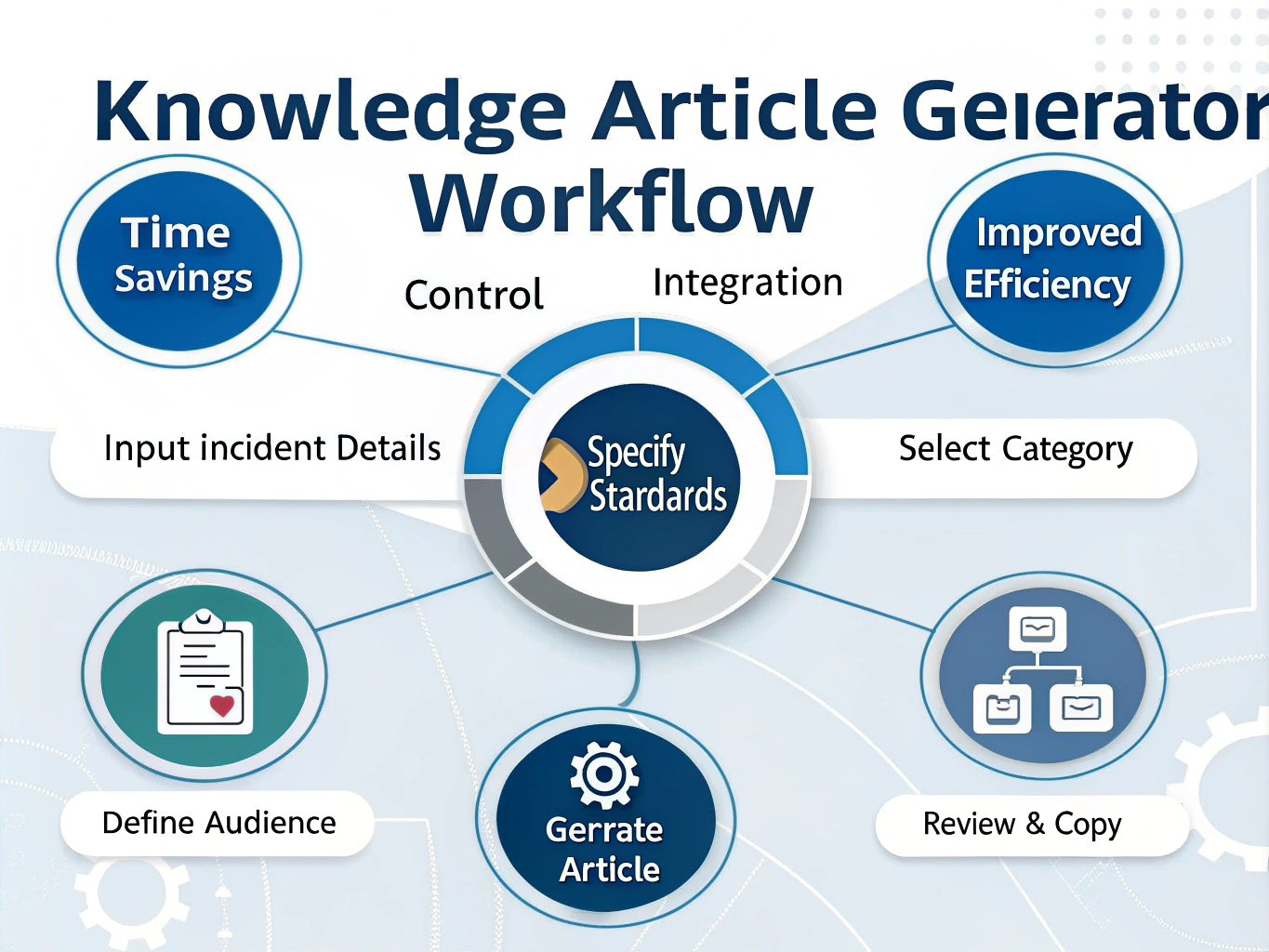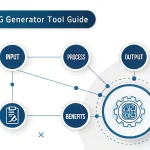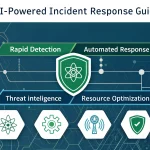Knowledge Article Generator
Is this tool helpful?
How to Use the Knowledge Article Generator Tool Effectively
Step-by-Step Guide
To make the most of our Knowledge Article Generator Tool, follow these simple steps:
- Provide Incident Details: In the first text area, enter a comprehensive description of the incident or problem. For example:
- “A distributed denial-of-service (DDoS) attack targeted our main e-commerce platform, causing intermittent outages for customers over a 4-hour period. The attack originated from multiple IP addresses and overwhelmed our load balancers.”
- “An unauthorized access attempt was detected on our customer database server, triggering multiple failed login alerts. Upon investigation, it was discovered that an employee’s credentials were compromised due to a phishing email.”
- Outline Knowledge Base Standards (Optional): If your organization has specific guidelines for knowledge articles, input them in the second text area. This helps tailor the generated article to your company’s standards.
- Provide Category Taxonomy (Optional): Enter the main categories or tags used in your knowledge base. This assists in properly classifying the generated article.
- Specify Target Audience: Identify who the knowledge article is intended for, such as “IT Security Team” or “Customer Support Representatives.”
- Generate the Article: Click the “Generate Knowledge Article” button to create your comprehensive knowledge article based on the provided information.
- Review and Copy: Once generated, review the article in the results section. If satisfied, use the “Copy to Clipboard” button to easily transfer the content to your knowledge base system.
Revolutionizing Knowledge Management: The Power of Automated Article Generation
In today’s fast-paced IT environment, efficient knowledge management is crucial for maintaining high-quality service delivery and rapid incident resolution. The Knowledge Article Generator Tool is a game-changing solution designed to streamline the process of creating comprehensive, standardized knowledge articles from incident or problem resolutions.
This innovative tool leverages advanced natural language processing and machine learning algorithms to transform raw incident data into well-structured, informative knowledge articles. By automating this traditionally time-consuming task, organizations can significantly improve their knowledge base quality, consistency, and overall IT service management (ITSM) efficiency.
Key Features of the Knowledge Article Generator Tool
- Intelligent Information Extraction: Automatically identifies and extracts critical details from incident or problem records.
- Standardized Formatting: Applies best practices for article structure, including headings, bullet points, and clear formatting.
- Smart Categorization: Suggests relevant categories, tags, and metadata based on the content for easy retrieval.
- Compliance with Knowledge Base Standards: Ensures generated articles adhere to predefined organizational guidelines.
- Customizable Output: Tailors the article content and style to suit different target audiences within the organization.
- Seamless Integration: Designed to work with existing ITSM tools and knowledge base systems for a streamlined workflow.
Benefits of Using the Knowledge Article Generator Tool
1. Time and Resource Optimization
By automating the knowledge article creation process, IT teams can save significant time and resources. What once took hours of manual writing and formatting can now be accomplished in minutes, allowing staff to focus on more critical tasks and complex problem-solving.
2. Improved Knowledge Base Quality and Consistency
The tool ensures that all generated articles follow a standardized format and adhere to organizational best practices. This consistency enhances the overall quality of the knowledge base, making it easier for users to find and apply relevant information quickly.
3. Enhanced Knowledge Sharing and Collaboration
With the simplified article creation process, team members are more likely to contribute to the knowledge base regularly. This fosters a culture of knowledge sharing and collaboration, leading to improved problem-solving capabilities across the organization.
4. Faster Incident Resolution
By having a comprehensive and easily searchable knowledge base, support teams can quickly access relevant information to resolve similar issues in the future. This leads to faster incident resolution times and improved service levels.
5. Reduced Knowledge Loss
The tool helps capture and preserve valuable institutional knowledge that might otherwise be lost due to staff turnover or the challenges of manual documentation. This ensures that critical information remains accessible to the organization over time.
6. Continuous Improvement of IT Services
With a more robust and up-to-date knowledge base, organizations can better analyze trends, identify recurring issues, and implement proactive measures to prevent future incidents.
Addressing User Needs and Solving Specific Problems
Streamlining Knowledge Capture
One of the primary challenges in knowledge management is the timely and accurate capture of information from incident resolutions. The Knowledge Article Generator Tool addresses this by:
- Automatically extracting key details from incident records
- Organizing information into a logical, easy-to-follow structure
- Prompting users for additional context or clarification when needed
For example, if an incident description mentions a specific error code, the tool will highlight this information and include it in a dedicated “Error Codes” section of the article for easy reference.
Ensuring Consistency and Compliance
Maintaining consistency across knowledge articles and ensuring compliance with organizational standards can be challenging, especially in large teams. The tool solves this problem by:
- Applying predefined templates and formatting rules
- Enforcing the use of standardized terminology and acronyms
- Automatically including required sections, such as “Root Cause” and “Resolution Steps”
For instance, if your organization requires all knowledge articles to include a “Time to Resolution” field, the tool will automatically prompt for this information and include it in the generated article.
Facilitating Easy Retrieval and Searchability
A common issue with knowledge bases is the difficulty in finding relevant information quickly. The Knowledge Article Generator Tool addresses this by:
- Automatically generating appropriate tags and categories based on content analysis
- Creating clear, descriptive titles that highlight the main issue and resolution
- Including a summary section at the beginning of each article for quick scanning
For example, an article about resolving a VPN connection issue might be automatically tagged with “VPN,” “Network,” and “Remote Access,” making it easily discoverable for future reference.
Practical Applications and Use Cases
1. IT Help Desk Support
In a busy IT help desk environment, the Knowledge Article Generator Tool can significantly improve first-call resolution rates and overall efficiency. When a support agent resolves a unique or complex issue, they can quickly generate a knowledge article that captures the problem, troubleshooting steps, and resolution.
Example scenario: A support agent successfully resolves an issue where a critical business application is crashing due to a specific combination of software versions. Using the tool, they can quickly create a detailed knowledge article outlining the problem, affected systems, and step-by-step resolution process. This article can then be immediately available to other agents, reducing the time to resolve similar issues in the future.
2. Change Management Documentation
The tool can be invaluable in documenting changes to IT infrastructure or applications. After implementing a change, engineers can use the Knowledge Article Generator to create comprehensive documentation of the change process, including pre-change preparations, implementation steps, and post-change verification procedures.
Example scenario: A system administrator implements a major update to the organization’s email server. Using the tool, they can generate a detailed knowledge article that includes the update version, compatibility requirements, backup procedures, step-by-step update instructions, and post-update testing protocols. This documentation ensures that future updates can be performed consistently and efficiently.
3. Security Incident Response
In the realm of cybersecurity, quick access to accurate information is crucial. The Knowledge Article Generator Tool can help security teams document and share information about security incidents, attack patterns, and mitigation strategies.
Example scenario: A security analyst successfully mitigates a new type of phishing attack targeting the organization. They use the tool to create a comprehensive knowledge article detailing the attack’s characteristics, indicators of compromise, containment procedures, and preventive measures. This information can be quickly disseminated to the security team and relevant stakeholders, enhancing the organization’s overall security posture.
4. New Employee Onboarding
The tool can assist in creating and maintaining up-to-date onboarding documentation for new IT staff. By generating knowledge articles based on common onboarding tasks and frequently asked questions, organizations can ensure a smooth and consistent onboarding experience.
Example scenario: An IT manager uses the Knowledge Article Generator to create a series of articles covering various aspects of the onboarding process, such as setting up workstations, accessing key systems, and following security protocols. These articles can be easily updated as processes change, ensuring that new employees always have access to the most current information.
5. Problem Management and Root Cause Analysis
The tool can be particularly useful in documenting the outcomes of problem management activities and root cause analyses. By generating detailed knowledge articles from these processes, organizations can build a valuable repository of information for preventing future incidents and improving overall service quality.
Example scenario: A problem management team identifies the root cause of recurring network outages in a specific branch office. Using the Knowledge Article Generator, they create a comprehensive article detailing the investigation process, findings, implemented solutions, and preventive measures. This documentation not only helps resolve the immediate issue but also provides valuable insights for similar situations in other locations.
Frequently Asked Questions (FAQ)
1. Can the Knowledge Article Generator Tool integrate with my existing ITSM system?
Yes, the tool is designed to integrate seamlessly with most popular ITSM platforms. It can pull incident data directly from your system and, in many cases, push the generated articles back into your knowledge base.
2. How does the tool handle technical jargon and acronyms?
The Knowledge Article Generator is equipped with a customizable glossary feature. You can input your organization’s specific technical terms and acronyms, ensuring that the generated articles use consistent and accurate terminology.
3. Can I edit the generated articles before finalizing them?
Absolutely. The tool provides a draft version of the article that you can review and edit as needed before finalizing. This allows you to add any additional context or make adjustments to suit your specific needs.
4. How does the tool handle sensitive or confidential information?
The Knowledge Article Generator includes configurable content filtering options. You can set up rules to automatically redact or flag potentially sensitive information, ensuring that confidential data is not inadvertently included in the generated articles.
5. Can the tool generate articles in multiple languages?
Yes, the tool supports multiple languages and can generate articles based on the language settings you specify. This is particularly useful for organizations with global operations or multilingual support teams.
6. How often should I update the knowledge base standards in the tool?
It’s recommended to review and update your knowledge base standards in the tool whenever there are significant changes to your organization’s documentation practices or ITSM processes. Regular reviews, such as quarterly or bi-annually, can help ensure the tool remains aligned with your evolving needs.
7. Can the tool help in identifying knowledge gaps in our existing knowledge base?
Yes, the Knowledge Article Generator includes analytics features that can help identify areas where your knowledge base may be lacking. It can suggest topics for new articles based on recurring incidents or problems that don’t have corresponding knowledge articles.
8. How does the tool ensure that generated articles are easy to understand for the specified target audience?
The tool uses natural language processing algorithms to adapt the content’s complexity and technical depth based on the specified target audience. For example, articles intended for end-users will use simpler language and more explanations, while those for IT specialists may include more technical details.
9. Can the tool generate articles for different types of knowledge, such as how-to guides or troubleshooting procedures?
Yes, the Knowledge Article Generator is versatile and can create various types of knowledge articles. You can specify the article type (e.g., how-to guide, troubleshooting procedure, reference document) when inputting the incident details, and the tool will structure the content accordingly.
10. How does the tool handle updates to existing knowledge articles?
When generating an article on a topic that already exists in the knowledge base, the tool can compare the new information with the existing article. It will then suggest updates or create a new version of the article, allowing you to review the changes before publication. This helps keep your knowledge base current and avoids duplication of information.
Important Disclaimer
The calculations, results, and content provided by our tools are not guaranteed to be accurate, complete, or reliable. Users are responsible for verifying and interpreting the results. Our content and tools may contain errors, biases, or inconsistencies. We reserve the right to save inputs and outputs from our tools for the purposes of error debugging, bias identification, and performance improvement. External companies providing AI models used in our tools may also save and process data in accordance with their own policies. By using our tools, you consent to this data collection and processing. We reserve the right to limit the usage of our tools based on current usability factors. By using our tools, you acknowledge that you have read, understood, and agreed to this disclaimer. You accept the inherent risks and limitations associated with the use of our tools and services.







